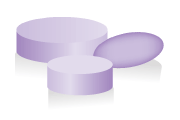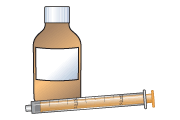Codeine phosphate for pain
This leaflet is for parents and carers about how to use this medicine in children. Our information may differ from that provided by the manufacturers, because their information usually relates to adults. Read this leaflet carefully. Keep it somewhere safe so that you can read it again.
Wait at least 6 hours between doses of Codeine. Do not give other medicines that contain Codeine.
Do not give Codeine to children who have just had their tonsils and/or adenoids removed or who have problems with obstructive sleep apnoea (snoring with pauses in their breathing).
MHRA advice is not to use this medicine in under 12 year olds.
Name of medicine
Codeine phosphate (often referred to as codeine)
Why is it important for my child to take Codeine?
It is important to give codeine, as advised by your doctor, to control your child’s pain.
A very small number of children do not respond well to Codeine, and it may be harmful even when taking the correct dose (amount) – see the box Signs of overdose or toxicity on page 2.
What is Codeine available as?
- Tablets: 15 mg, 30 mg, 60 mg
- Clear liquid medicine: 25 mg in 5 mL; contains a small amount of sugar and ethanol. If you have any concerns or questions, speak with your child’s doctor or pharmacist.
- Suppositories: a range of strengths are available
When should I give Codeine
- If your child needs help with pain day and night for several days (continuous pain), give the doses of codeine every 6 hours to help stop the pain from coming back.
- If your child has pain that comes and goes (intermittent pain), give a dose of codeine when they first complain of pain. Wait at least 6 hours before giving another dose. You must not give your child more than four doses of codeine in 24 hours.
Write down the time that you give each dose, to help you remember.
How much should I give?
Your doctor will work out the amount of Codeine (the dose) that is right for your child. The dose will be shown on the medicine label.
It is important that you follow your doctor’s instructions about how much to give.
How should I give Codeine?

Tablets
- Tablets should be swallowed with a glass of water, squash or juice. Your child should not chew the tablet.

Liquid medicine
- Shake the medicine well.
- Measure out the right amount using an oral syringe or a medicine spoon. You can get these from your pharmacist. Do not use a kitchen teaspoon as it will not give the right amount.

Suppositories
- Suppositories are inserted into the rectum (back passage).
- Ideally your child should open their bowels (do a poo) before you administer Codeine suppositories.
- Wash your hands with soap and hot water.
- Your child should be lying on his or her side or front.
- Hold one buttock gently to one side so that you can see the back passage.
- Unwrap the suppository and hold the it with the rounded end close to the back passage.
- Use one finger to push the suppository gently into the back passage. It needs to go in by about 2 cm. (You can use lubricating gel to make the insertion more comfortable.)
- Your child should stay lying down for about 15 minutes, and ideally for an hour, so that the suppository doesn’t come out.
- Wash your hands again with soap and hot water.
- If your child empties their bowels (does a poo) within 30 minutes of inserting a suppository, you may need to insert another one.
Suppositories must not be taken by mouth.
When should the medicine start working?
Your child should start to feel less pain within half an hour after taking codeine. It may take up to an hour for the codeine to work fully. If you are worried about whether it is helping, contact your doctor.
What if my child is sick (vomits)?
- For tablets and liquid medicine: If your child is sick after having a dose of codeine (by mouth), do not give them another dose. Wait until the next normal dose. Contact a doctor, pharmacist or hospital for advice.
- For suppositories: You do not need to worry if your child is sick, as the suppositories will still work
What if I forget to give it?
If your child is in pain, give the missed dose as soon as you remember. You must then wait at least 6 hours before giving the next dose.
Never give a double dose of Codeine.
What if I give too much?
Your child may not show any of the symptoms outlined in the box Signs of overdose or toxicity. If you think you may have given them too much codeine, contact your doctor or local NHS services (details at end of leaflet) or take your child to hospital.
Take the medicine container or packaging with you, even if it is empty. This will be useful to the doctor. Have the medicine or packaging with you if you telephone for advice.
It can be dangerous to give too much Codeine.
If you have given your child an extra dose of Codeine by mistake, wait at least 8 hours before giving any more.
Are there any possible side effects?
We use medicines to make our children better, but sometimes they have other effects that we don’t want (side effects).
Side effects you must do something about
Signs of overdose or toxicity
If your child has any, or all, of the following symptoms, they may have had too much codeine or it may be toxic – call for an ambulance straight away:
- finding it difficult to breathe or breathing slowly
- a fast or slow heartbeat (they may say their heart feels fluttery or is racing)
- muscle twitching
- dizziness
- feeling very sleepy or you are unable to wake them
If your child has hallucinations (sees things that aren’t there), contact your doctor straight away.
Other side-effects you need to know about
If you are concerned about any of these side-effects, contact your doctor, but continue to give the codeine phosphate.
- Your child may become constipated.
- Some children find that their eyesight is blurry or double.
- Your child may find it difficult to pass urine (do a wee).
Your child may feel sick (nausea) or be sick (vomit). Giving the medicine with some food or milk may help. This effect is usually worst in the first few days of treatment. If vomiting is severe or you are worried, contact your doctor.
Your child may have a dry mouth. Eating citrus fruits (e.g. oranges) and sipping water may help.
Your child may be sweaty, sleepy (drowsy), have a headache (they may say their head is painful or pounding), feel dizzy, or have pins and needles.
Your child may have changes in mood or have sleep disturbances such as difficulty getting to sleep.
There may sometimes be other side effects that are not listed above. If you notice anything unusual and are concerned, contact your doctor. You can report any suspected side effects to a UK safety scheme at mhra.gov.uk/yellowcard
Can other medicines be given at the same time as Codeine?
- You can give your child medicines that contain paracetamol or ibuprofen, unless your doctor has told you not to.
- Codeine should not be taken with some medicines. Tell your doctor or pharmacist about any other medicines your child is taking before giving Codeine.
Check with your doctor or pharmacist before giving any other medicines to your child. This includes herbal and complementary medicines.
- Some painkillers and cough medicines contain Codeine (you can find this information on the label). Do not give these to your child if you have given them Codeine.
Is there anything else I need to know about this medicine?
- If your child has asthma or epilepsy, check with your doctor or pharmacist that you can give them codeine.
- You may have heard that some people become addicted to or dependent on codeine. This is unlikely to happen when codeine is given to children in pain for short periods of time.
General advice about medicines
- If you are not sure a medicine is working, contact your doctor but continue to give the medicine as usual in the meantime. Do not give extra doses, as you may do harm.
- Only give this medicine to your child. Never give it to anyone else, even if their condition appears to be the same, as this could do harm.
- Write down the times that you give Codeine, to help you remember, and to make sure that you don’t give too much.
- Make sure that you always have enough medicine. Order a new prescription at least 2 weeks before you will run out.
- Make sure that the medicines you have at home have not reached the ‘best before’ or ‘use by’ date on the packaging. Give old medicines to your pharmacist to dispose of.
If you think someone else may have taken the medicine by accident, contact a doctor straight away. If they show any of the symptoms listed in the Signs of overdose or toxicity box, take them to hospital straight away.
Where should I keep this medicine?
- Keep the medicine in a cupboard, away from heat and direct sunlight.
- It does not need to be kept in the fridge.
- Make sure that children cannot see or reach the medicine.
- Keep the medicine in the container it came in.
Who to contact for more information?
Your doctor, pharmacist or nurse will be able to give you more information about Codeine and about other medicines used to treat pain.
England: NHS 111
Tel 111
www.nhs.ukScotland: NHS 24
Tel 111
www.nhs24.scotNorthern Ireland: NI Direct
Wales: NHS 111 Wales
Tel 111
www.111.wales.nhs.ukCopyright disclaimer
Version [2]. © NPPG, RCPCH and WellChild, all rights reserved. Review by May 2017.
The primary source for the information in this leaflet is the British National Formulary for Children. For details on any other sources used for this leaflet, please contact us through our website, www.medicinesforchildren.org.uk.
We take great care to make sure that the information in this leaflet is correct and up-to-date. However, medicines can be used in different ways for different patients. It is important that you ask the advice of your doctor or pharmacist if you are not sure about something. This leaflet is about the use of these medicines in the UK, and may not apply to other countries. The Royal College of Paediatrics and Child Health (RCPCH), the Neonatal and Paediatric Pharmacists Group (NPPG), WellChild and the contributors and editors cannot be held responsible for the accuracy of information, omissions of information, or any actions that may be taken as a consequence of reading this leaflet.
